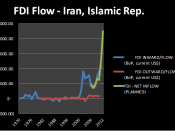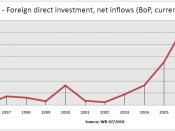FDI Paper / Nissan North America
In this paper I will investigate Nissan's foreign direct investment (FDI) in Canton, Mississippi. I will discuss decisions by Nissan and the economic picture in the region. I will also analyze the important reasons for the FDI in Canton and the forecast of the long-term results.
While sales on automobiles are down around the globe, investments by car manufacturers and their subsequent suppliers are still barely surviving. Expansions and new assembly plants for everyone involved continue to surge ahead as original equipment manufacturers (OEMs) and assemblers attempt to carve out market shares.
While manufacturers compete against each other, they seek more cost-effective production, tighter margins, and better logistics management from suppliers. With producers and suppliers in the auto industry constantly checking that their location is providing good value, development agencies are going all out to attract and retain their business.
In the U.S.,
the world's biggest vehicle market, the stakes are high. Up against Asian and European manufacturers, American car markers continue to offer discounts and zero financing to boost sales. In the pickup truck category - largely driven by Detroit's Big Three, General Motors (GM), Ford and DaimlerChrysler - GM's Chevy pickup now has a new competitor Nissan, which has now joined the stampede (Efficiency Drive).
Nissan has rolled off its first Titan pickup truck at its expanded factory in Canton, Mississippi. This is tough competition for the Big Three, which have been accused by Business Week magazine of having trouble staying ahead of the innovation curve. And now, with Nissan's $1.4 billion plant employing more than 5,000 workers and with an increased capacity from 250,000 vehicles to 400,000, GM and others can no longer keep their gears in neutral (Efficiency Drive).
Nissan will add 150,000 trucks to the slow-growing U.S.



FDI Paper / Nissan North America
An incomplete essay. Not worth reading.
0 out of 0 people found this comment useful.